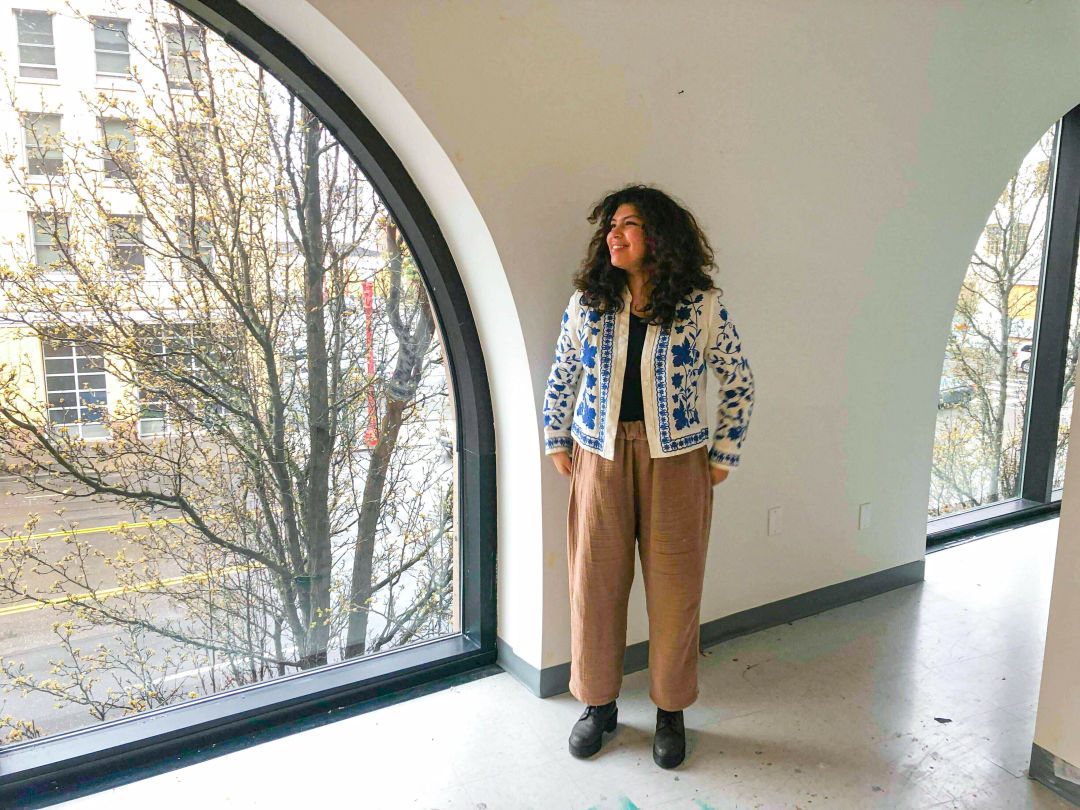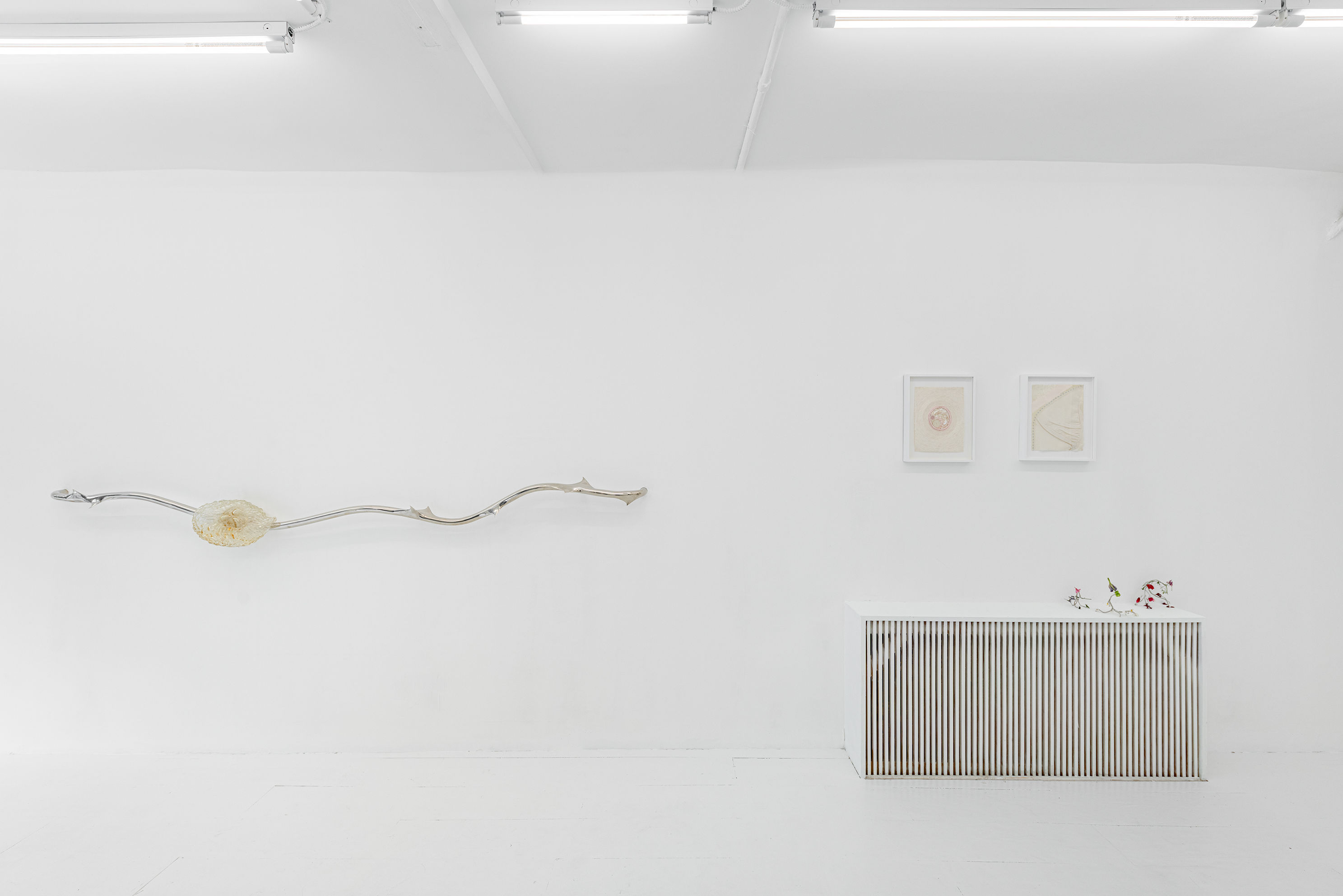A New Old Town Studio Collective Looks to Uplift Artists of Color

Salomée Souag in the Old Town studio space where she is hoping to start an artists' collective.
Image: Julia Silverman
When muralist and sculptor Salomée Souag went looking for a BIPOC-centered, artist-run studio collective where tenants could lease space to work and collaborate, it didn’t take her long to figure that what she wanted didn’t exist—yet. So she decided to start one.
In the summer of 2020, when Black Lives Matter demonstrations pulsed through the streets, Souag's art covered the city. Overnight, it seemed like her wheat-pasted posters bearing bold, serif fonts were everywhere; commissions for her exuberant murals have poured in ever since (find her work on the walls of ReClaimIt on N. Killingsworth, on the side of the Jupiter Hotel, and spanning an overpass that crosses N. Greeley at the Adidas campus, among other locations).
But living and creating every day takes its toll. To sustain herself, she needed community, says Souag. Easier said than done: studio space is at a premium in Portland, with rents continuing to rocket long after iconic communal spots like Southeast Portland’s Towne Storage and Troy Laundry were priced out in the 2010s.
Of the studio collectives that remain, none were created by and for artists of color, or offered the community feel Souag was looking for. Property owner Ken Unkeles has 175 studio spaces in four different warehouses across town, including at Northwest Marine Art Works on NW 29th; rents start at $150 and go up to an improbable $14,000 a month for his largest industrial client. Unkeles's sometime-business partner David Gold owns the Pickle Factory, a light-washed conversion on N. Columbia Boulevard with studios slotted in next to offices; the city put its muscle behind the live-work studios at the Milepost 5 affordable housing complex on the edge of Montavilla.
Nothing felt quite right to Souag, though. She saw windowless basements. She saw studios asking $600 a month; taped-off squares in the middle of giant, unfamiliar rooms. “Nothing felt like I could work there safely, with a community, with inspiration," she says. "And I felt like, if I need this thing, other people have to be looking as well.”
Enter 321 NW Glisan, owned by Brian Wannamaker, a Portland developer and arts patron whom Willamette Week dubbed the “Medici of Portland” back in 2013. That was just after he bought and renovated a three-story apartment building on N Albina Ave that became the Falcon Art Community, where dozens of artists have lived, worked, and exhibited in exchange for low rents.
In 2015, Wannamaker bought 321 NW Glisan for $9.3 million. The Glisan Street building is on the edge of Old Town-Chinatown opposite Blanchet House headquarters; pre-pandemic, the area was on something of a come up, with new anchors like the Society Hotel and the University of Oregon’s Portland HQ mixing with social services agencies, creative/industrial warehouse spaces, and fratty nightlife. That was then.
Now, Old Town can feel like a forgotten planet. Entire buildings sit vacant or nearly so, including Wannamaker’s. Souag, though, knew Wannamaker and began working out of a temporary studio on the building’s first floor in late 2021; on a whim, she asked if she could tour the upstairs.
Immediately, she fell for the space’s defining feature: giant arched windows that flood the white-walled space with light, even on Portland’s grayest days. The location, a liability for more buttoned-up interests, drew her in—a chance, she and her friend Anna Barlow figured, to be a force for change as opposed to gentrification. So the pair have decided to use the space to start the collective of Souag's dreams. They imagine a woodworking studio, pottery wheels, and a kiln; maybe a darkroom or space for a piano.
Spurring on Souag's vision: the Creative Heights grant program, administered by the Oregon Community Foundation, now in its eighth year. Artists and arts groups can get up to $100,000 over two years to execute a visionary project; past recipients have included photographer Intisar Abioto, who is developing a retreat for Black artists, curators and administrators in Oregon, and the Oregon Shakespeare Festival, to commission digital work by Indigenous artists. Souag is gunning for the 2022 grant cycle; being fully funded, she says, will allow her to offer studio space at 321 NW Glisan rent-free to the initial cohort of artists and to add shared creative tools to the space.
The Creative Heights grant is highly competitive, says Jerry Tischleder, who oversees statewide arts and culture grants for OCF. It’s intended as “risk capital for big, bold ideas,” must have a nonprofit partner and typically focuses on artistic visions or projects, as opposed to infrastructure. This year, there are 233 applicants; usually, only 10 recipients are chosen to split a million-dollar pot. In April, Souag and Barlow will find out if they’ve made it through to the second round; winners are announced in August.
Even without the grant, though, Souag and Barlow are forging ahead. Applications for a studio space are open now until March 31. There’s room for 11 artists, who will pay on a sliding scale between $150 and $350 a month for three-sided “micro-studios,” each about nine feet by nine feet. (A handful of larger, more secluded spaces are also available.) In exchange for the low rents, artists in residence will lead workshops with Color Outside the Lines, a nonprofit Barlow directs that connects kids in foster care with chances to make art.
The goal is to open by May 1, and prospective artists are already filing through. During a recent walk-through of the space, Bernadette Little, an art director at Adidas who is also an illustrator and designer, says working from home has left her craving community, but the expense of dedicated studio space has felt insurmountable.
“Having someone take a risk on you like this is not something that happens every day,” Little says. “Being an artist is already a leap of faith. You can’t always take a risk on yourself.”
Souag is clear that BIPOC artists are being prioritized, though anyone can apply. It’s evident that she’s hoping to build the community she couldn’t find.
"A lot of people are really low right now, because they are dealing with the aftermath of being alone," Souag says. "We don't want to go into a collective that is just founded all by white people with the white savior complex that want to help us. We want to see ourselves as the people who are helping us.”




